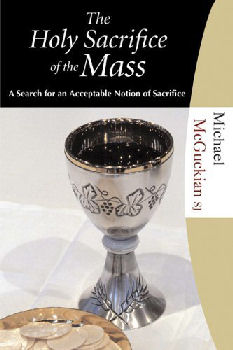
|
Posted March 29, 2006
Book: The Holy Sacrifice of the Mass: A Search for an Acceptable Notion of Sacrifice Author: Michael McGuckian, S.J. Hillenbrand Books, Chicago, IL, 2005, pp.134 An Excerpt from the Jacket:
An Excerpt from the Book: The Active Participation of the Faithful Yet another related question is that of the active participation of the faithful in the Eucharistic liturgy, which is the goal of the reform of the liturgy mandated by the Second Vatican Council. A proper understanding of sacrifice has a very important contribution to make to this issue. Let us begin our consideration of this aspect by listening to a comment by Yerkes about a fundamental aspect of the traditional understanding of sacrifice. In modern English two groups of verbs are related to worship. A person may be described as 1 saying or reading or singing, or 2 performing or conducting or celebrating a religious service. In both instances the verb describes the action of a single person, or of a very small group of persons. Others who may be present are spectators or auditors who attend or watch or hear the service, which may be perfectly transmitted by radio or television . . .we have become so accustomed to this method of thinking that we do no always realize the radically different concept of worship which obtained among ancient Greeks. Verbs of saying and performing and hearing and seeing were proper for pageantry and play; they had no place in descriptions of a thusia, for which the only adequate verbs were those of group action in which every member had a part; none was a mere spectator or auditor. So, if one is truly sacrificing, one is of necessity active. And Dix makes the same point at considerable length in relation to Christian sacrifice. He points out that: . . . the general conception. . . . of what the Eucharist fundamentally is. . .[is] something which is said, to which is attached an action, the act of communion. . . regards ths, of course, as an essential constituent part of the whole, but it is nevertheless something attached to the “saying,” and rather as a consequence than as a climax. The conception before the fourth century and in the New Testament is almost the reverse of this. It regards the rite as primarily something done, of which what is said is only one incidental constituent part, though of course an essential one. . .We all find it easy and natural to use such phrases as, of the clergy, “saying Mass,” and of the laity, “hearing Mass”. . .The ancients on the contrary habitually spoke of “doing the Eucharist,” peforming the mysteries,” “making the synaxis,” “doing the offering.” And there is a further contrast, that while our language implies a certain difference between the functions of the clergy and the laity, “saying” and “hearing” Mass,” the ancients used all their active language about “doing” the liturgy quite differently of laity and clergy alike. The irreplaceable function of the celebrant, his “special liturgy,” was to “make” the prayer; just as the irreplaceable function of the deacon or the people was to do something else which the celebrant did not do. There was difference of function but no distinction in kind between the activities of the different orders in the worship of the whole Church. . . . And what is it that people principally “do” in offering a sacrifice? We have already seen Dix making clear that the people’s part in the offering of a sacrifice is precisely the Offertory. This point has been well made more recently by a Catholic commentator on the liturgy. He is speaking of the history of the Offertory, but in the context of our discussion we can understand him to be speaking of the reality of the sacrifice. All of these gifts were looked upon as being a contribution to the sacrifice; and in the offering of these gifts one could see how each member of the congregation expressed concretely his intention of taking active part in the sacrifice, and of making an offering of his very self. The fact that most of the oblations, in an age which was accustomed to trade in kind, were products of labor of the people’s own hands served to enhance the symbolism of the offertory gift in the mind of individual worshiper. For in his gift at the offertory, he have something of his own substance, something fundamental to his very existence and by doing this represented the giving of himself. The practical effect of such oblations was at one and the same time to provide an economic foundation for the existence of the clergy and of the Church’s work of charity; the cerly, like the poor, lived so to speak “from the altar”; and the Eucharistic sacrifice was at the same time the very source of the charitable activity of Christians. Table of Contents: 1. A “true and proper” sacrifice 2. Two Old Testament models of sacrifice 3. The Last Supper and the early Eucharist 4. The offertory in tradition 5. The meal theory of sacrifice 6. The sacrifice of the Cross 7. The sacramental sacrifice |
|
